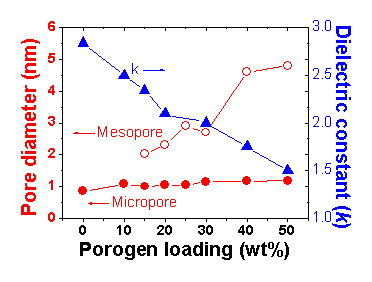|
Porous low-k thin films
|
Pore percolationPALS is capable of distinguishing between open and closed pore structure based on the intensity of the Ps signal in vacuum.
This will allow us to determine the evolution of pore structures and the percolation threshold, i.e., the closed-to-open pore transition in porous films. |
|
|
Figure 1. Ps intensities |
A series of porous MSSQ films from Lucent, with different weight percentage of porogen (range from 0 ~ 50%) are used to illustrate PALS sensitivity to percolation threshold. The intensities of the Ps annihilating in the film and in vacuum are plotted in Figure 1. The in-film intensity results from Ps annihilating in the closed porosity (Io-Ps, including Ps in both mesopores and micropores) while the vacuum intensity (Ivacuum) consists of the systematically backscattered Ps (~ 2 % at 5.0 keV) and the escaped Ps from open porosity. When the porogen loading increases to 25 wt%
Obviously, some Ps formed in the film has managed to diffuse into vacuum as the porogen loading goes above 25 wt%. Therefore, this loading is believed to be the nominal pore percolation threshold for Ps (more precisely, the threshold is in the range of 20-25%). At this threshold, the mesopores start to merge with or connect to the surrounding pores and, as a result, open paths to the free surface can be formed. |

Figure 2. Pore sizes and dielectric constants. |
|
|
To determine the pore size, a capping layer (as Ps diffusion barrier) is required for pore size determination in those films above percolation threshold whereas below the percolation threshold, there is no need for a capping layer, since all the pores generated in the films are closed and isolated.
|
|
|
Summary:
References:
|
|